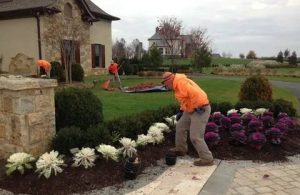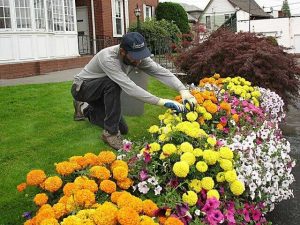
Landscape maintenance includes a range of activities aimed at keeping a landscape healthy, attractive, and well-maintained. Here are some common tasks and services that are typically included in landscape maintenance:
Lawn care:
Lawn care is indeed one of the key tasks and services that are commonly included in landscape maintenance. Here are some specific activities related to lawn care:
- Mowing: Regularly mowing the lawn to maintain an even height and promote healthy grass growth. This includes using appropriate mowing techniques, such as not cutting the grass too short and varying the mowing pattern.
- Edging: Creating clean and defined borders between the lawn and other landscape features, such as flower beds, walkways, or driveways. Edging helps maintain a neat and polished appearance.
- Trimming: Trimming or cutting back grass around obstacles like trees, shrubs, fences, or structures that cannot be reached with a mower. This ensures that the entire lawn area is properly maintained.
- Aeration: This involves creating small holes in the soil to improve air circulation, water absorption, and nutrient uptake. Aeration helps alleviate soil compaction, promoting healthier grass roots.
- Overseeding: Spreading additional grass seed over existing turf to fill in thin or bare areas. Overseeding helps thicken the lawn and improve its overall appearance.
- Dethatching: Removing the layer of dead grass, roots, and other organic matter (thatch) that accumulates on the surface of the soil. Dethatching helps prevent the buildup of thatch, which can impede water, air, and nutrient penetration.
- Weed control: Applying herbicides or manually removing weeds from the lawn to prevent their growth and maintain a weed-free appearance.
- Fertilization: Applying lawn fertilizers at appropriate times and in appropriate quantities to provide essential nutrients for healthy grass growth. Fertilization helps promote lush, green, and robust turf.
Plant care
Plant care is indeed an important component of landscape maintenance. Here are some specific tasks and services related to plant care that are typically included:
- Pruning and trimming: Regularly trimming and pruning plants to maintain their shape, remove dead or diseased branches, and promote healthy growth. This includes shrubs, trees, hedges, and ornamental plants.
- Watering: Providing plants with adequate water to ensure proper hydration. This involves monitoring soil moisture levels and adjusting watering frequency and duration based on plant needs and weather conditions.
- Mulching: Applying a layer of organic material, such as wood chips or compost, around plants’ base to conserve moisture, suppress weed growth, regulate soil temperature, and improve soil fertility.
- Fertilization: Supplying plants with essential nutrients through the application of fertilizers. This helps promote healthy growth, vibrant foliage, and robust blooms. The timing and type of fertilizers used may vary depending on plant species and specific requirements.
- Soil testing and amendment: Assessing the soil composition and pH levels to determine if any amendments are needed to improve its quality. This may involve adding organic matter, adjusting pH levels, or addressing specific nutrient deficiencies.
- Disease and pest management: Monitoring plants for signs of diseases or pests and implementing appropriate control measures. This may include the use of organic or chemical treatments, insecticides, or beneficial insects for natural pest control.
- Weed control: Regularly removing weeds from plant beds and around plants to prevent competition for resources and maintain a clean and tidy appearance. This can be done manually or through the use of herbicides or mulching techniques.
- Seasonal maintenance: Conducting specific tasks based on the season, such as winterizing plants, protecting them from frost or extreme heat, and preparing them for spring growth.

Weed control
Weed control is an important aspect of landscape maintenance to ensure the health and aesthetics of the landscape. Here are some tasks and services that are typically included in weed control:
- Weed identification: Knowledge of different weed species is crucial to effectively control and manage them. Landscape http://sbevolutionlandscape.com maintenance professionals can identify various types of weeds and determine the most appropriate control methods.
- Manual weed removal: Hand pulling or digging out weeds manually is a common method of weed control. This is typically done for small infestations or in areas where herbicides cannot be used.
- Mulching: Applying a layer of mulch around plants and in plant beds can help suppress weed growth by blocking sunlight and preventing weed seeds from germinating. Mulch also helps conserve soil moisture and regulate soil temperature.
- Herbicide application: In cases of larger weed infestations or when manual removal is not feasible, herbicides may be used to control weeds. Herbicides can be selective, targeting specific types of weeds, or non-selective, affecting a broader range of plants. Proper application techniques and adherence to safety guidelines are essential when using herbicides.
- Pre-emergent herbicides: These herbicides are applied before weed seeds germinate, creating a barrier that prevents their growth. Pre-emergent herbicides are effective in controlling annual weeds and can be used as a preventive measure.
- Post-emergent herbicides: These herbicides are applied directly to actively growing weeds. They target weeds that have already emerged and can help control both annual and perennial weeds.
- Integrated weed management: This approach combines multiple weed control strategies to effectively manage weeds. It may include a combination of manual removal, mulching, herbicide use, and cultural practices like proper mowing height and dense plant spacing to suppress weed growth.
- Regular monitoring: Regular inspections of the landscape to identify and address weed growth in its early stages can help prevent extensive infestations and make weed control more manageable.
Irrigation management
Irrigation management is an essential component of landscape maintenance, particularly in areas where water availability is limited or where plants require consistent and controlled watering. Here are some tasks and services typically involved in irrigation management:
- System design and installation: Planning and designing an efficient irrigation system tailored to the specific landscape’s needs. This includes determining the appropriate types of irrigation methods (such as sprinklers, drip irrigation, or micro-sprinklers), selecting the right components (pipes, valves, controllers), and strategically placing irrigation zones.
- Maintenance and repair: Regular inspection, maintenance, and repair of the irrigation system components. This involves checking for leaks, damaged or clogged sprinkler heads, malfunctioning valves, or issues with the irrigation controller. Prompt repairs are necessary to ensure the proper functioning of the system and prevent water waste.
- Irrigation scheduling: Developing a watering schedule based on factors such as plant requirements, soil conditions, weather patterns, and local regulations. This includes determining the frequency and duration of irrigation cycles to provide sufficient water without overwatering. Adjustments to the schedule may be made seasonally or as per specific plant needs.
- Water conservation practices: Implementing water-saving techniques to optimize irrigation efficiency. This may involve using moisture sensors or weather-based controllers to adjust irrigation schedules based on real-time data, installing rain sensors to prevent irrigation during rainfall, or incorporating water-saving technologies like drip irrigation or micro-sprinklers.
- Irrigation auditing: Conducting regular assessments of the irrigation system’s performance and water distribution. This involves checking for uniformity in water application, identifying areas of overspray or water runoff, and making necessary adjustments to improve water efficiency.
- Soil moisture management: Monitoring soil moisture levels to ensure plants receive adequate water without waterlogging or drought stress. This may involve using moisture meters or conducting visual inspections to assess soil moisture content and adjusting irrigation accordingly.
- Seasonal adjustments: Modifying the irrigation schedule and system settings based on seasonal variations in temperature, rainfall, and plant water requirements. This includes increasing irrigation during hot and dry periods and reducing irrigation during cooler or wet seasons.
- Water quality management: Considering the quality of water used for irrigation and addressing any issues that may affect plant health. This may include testing water quality for pH levels, mineral content, or contaminants and taking appropriate measures like filtration or treatment if needed.
Fertilization
Fertilization is an important aspect of landscape maintenance that helps provide essential nutrients to plants, promoting healthy growth and development. Here are some tasks and services typically included in fertilization as part of landscape maintenance:
- Soil testing: Conducting soil tests to assess the nutrient levels and pH balance of the soil. This helps determine the specific nutrient requirements of the plants and enables the selection of the appropriate fertilizers.
- Nutrient analysis: Analyzing the nutritional needs of plants based on factors such as plant type, growth stage, and environmental conditions. This helps determine the types and proportions of nutrients needed for optimal plant health.
- Fertilizer selection: Choosing the right fertilizers based on the specific nutrient requirements of the plants and the results of soil testing. Fertilizers may be organic or synthetic and can be tailored to address specific deficiencies or general plant nutrition.
- Fertilizer application: Applying fertilizers to the soil or directly to plant foliage in the appropriate quantities and at the correct times. This may involve using granular fertilizers spread on the soil surface, liquid fertilizers applied through irrigation systems, or foliar sprays applied to the leaves.
- Timing and frequency: Determining the optimal timing and frequency of fertilizer applications based on plant needs, growth cycles, and seasonal considerations. Fertilizer applications are often done during periods of active plant growth to maximize nutrient uptake.
Pest and disease management:
Pest and disease management is a crucial aspect of landscape maintenance to protect plants from damaging insects, pests, and diseases. Here are some tasks and services typically included in pest and disease management as part of landscape maintenance:
- Identification and monitoring: Regularly inspecting plants for signs of pests, insects, or diseases. This involves identifying the specific pests or diseases affecting the plants and assessing the severity of the infestation.
- Integrated Pest Management (IPM): Implementing an Integrated Pest Management approach that focuses on using multiple strategies to manage pests effectively while minimizing the use of chemical pesticides. IPM strategies may include cultural practices, biological controls, physical barriers, and targeted pesticide applications when necessary.
- Cultural practices: Implementing cultural practices that promote plant health and reduce pest and disease susceptibility. This may include proper plant spacing, pruning to improve air circulation, removing dead or infected plant material, and maintaining optimal soil conditions.
- Biological controls: Introducing beneficial insects, predators, or parasites that naturally control pest populations. This can include releasing ladybugs to control aphids or introducing nematodes to combat soil-borne pests.
- Physical barriers: Using physical barriers such as netting, screens, or fences to prevent pest access to plants. This can be particularly useful in protecting vulnerable plants from birds, rabbits, or larger pests.